|
Related FAQs: Merulinids 1, Merulinids 2, & FAQs on: Merulinid Identification, Merulinid Behavior, Merulinid Compatibility, Merulinid Selection, Merulinid Systems, Merulinid Feeding, Merulinid Disease, Merulinid Reproduction/Propagation,
& Stony/True Coral,
Coral System Set-Up, Coral System Lighting, Stony Coral Identification, Stony Coral Selection, Coral Placement, Foods/Feeding/Nutrition, Disease/Health, Propagation, Growing Reef Corals, Stony Coral Behavior, SPS Identification, SPS Behavior, SPS
Compatibility, SPS Selection,
SPS Systems, SPS Feeding, SPS
Disease, SPS
Reproduction,
Related Articles: Small
Polyp Stony Corals, Stony or True Corals,
Order Scleractinia, Dyed Corals,
/The Best Livestock For Your Reef Aquarium:
Corals of the Family
Merulinidae, Part 4
Part 1: To Echinopora
Part 2: Genus Hydnophora
Part 3: Genus Merulina
Part 5: Genus Pectinia
|
|
|
Bob Fenner
|
|
Genus Mycedium Oken 1815: Laminar colonies with corallites
facing the outer margins as leafy extensions. Up to 2m in diameter.
Separate corallites that protrude at angles. Septa exsert extending
beyond the surface toward the outer edges. /WA Corals: colonies laminar, can
form whorls • corallites exert, inclined to margin • no pits in skeleton held up
to the light
This genus was formerly placed in the family Pectiniidae.
Bigger PIX:
The images in this table are linked to large (desktop size) copies.
Click on "framed" images to go to the larger size. |
.JPG)
.JPG)
MD.JPG)
.JPG)
%20MD.JPG)
%20MD.JPG)
%20MD.JPG)
%20MD.JPG) |
| Mycedium elephantotus (Pallas 1776)
Elephant Nose or Peacock Coral. Polyps similar to Oxypora, but
face away (like periscopes) toward colony margins. Not commonly
offered, though a hardy, interesting coral, sometimes of great
colors. Appreciate bright lighting, mounting vertically or
otherwise placed in areas of low siltation. Right: Close up in N.
Sulawesi. Below: Red Sea, Fiji, N. Sulawesi images. |
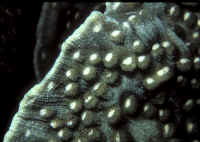
|
Bigger PIX:
The images in this table are
linked to large (desktop size) copies. Click on "framed"
images to go to the larger size. |
%20MD.jpg)
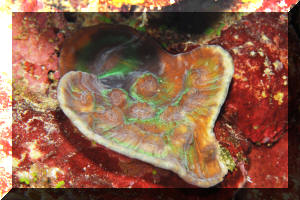 |
| Mycedium steenei Veron 2000. Delicate
colonies of less than a foot across, composed of uni-facial fronds
in succeeding whorls. N. Sulawesi pic. |
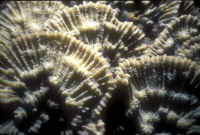
|
Genus Oulophyllia. Convex or hemispherical colonies of meandering
valleys with corallites arranged in short, discontinuous valleys (wider than
Platygyra; 10-20mm wide; thin, lamellar in Leptoria). /WA Corals: massive
or thick encrusting plates • corallites monocentric or in rows (meandroid) •
large deep valleys >2cm wide • large septal teeth • distinctive colonies
This genus was formerly placed in the family Faviidae by some.
See it there.
Genus Paragoniastrea Huang, Benzoni & Budd 2014. /WA Corals:
massive, encrusting • corallites are fully or partly meandroid • septa have fine
teeth • obvious paliform lobes • budding intratentacular
Genus Paramontastrea Huang & Budd 2014, /WA Corals: massive
colonies • exert plocoid corallites • granulated septocostae • paliform crown
http://www.corallosphere.org/genus/1861.html: The name sets this taxon in
contrast to other species present in both Indo-Pacific and Atlantic reefs that
were classed according to superficial similarities in the genus Montastrea
(sensu Veron, 1986: 502, 2000, vol. 3, p. 212). The latter is now restricted in
modern scleractinians to the phylogenetically distinct Atlantic species,
Montastraea cavernosa.
Paramontastrea peresi (Faure & Pichon
1978). /COTW:
Characters: Colonies
are encrusting and helmet-shaped, with neatly scalloped lower margins.
Corallites are angular and characteristically aligned in short shallow
radiating valleys at the colony margin. Septa are strongly beaded. A
small neat paliform crown is usually present. Budding is both intra- and
extratentacular.
Colour: Pinkish-tan.
Similar
Species: Unlike other Goniastrea. Goniastrea aspera does
not have corallites aligned in valleys. See also G. palauensis and Favites abdita.
Habitat: Shallow
reef environments.
Abundance: Common.
Taxonomic Note: Placed in Paramontastrea by Huang,
Benzoni, Fukami et al. (2014). Possibly warrants a separate genus.
Red Sea image. |
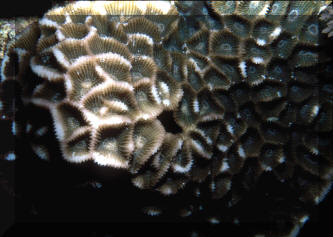 |
Genus Platygyra Ehrenberg 1834. Brain Corals. Massive colonies that
are either flat or rough boulder-like. Centers of corallites (columellae) are
sponge-like. If you look closely you can see rows of mouths along the valleys. Coelastrea
is a synonym for Platygyra according to COTW. /WA Corals: massive, encrusting •
corallites are ceroid • septa have fine teeth • obvious paliform lobes • budding
intratentacular
This genus was formerly placed in the family Faviidae by some.
See it there.
Bigger PIX:
The images in this table are linked to large (desktop size) copies. Click on
"framed" images to go to the larger size. |
|
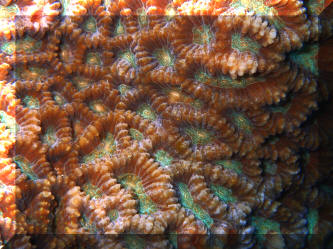
|
| Platygyra acuta Veron 2000. Boulder-like colonies
with meandering corallites that show sharp walls |
|
| Platygyra daedalea (Ellis &
Solander 1786). Massive, encrusting to hemispherical colonies that are
meandroid, with corallites that are thick-walled. Exsert septa that appear
ragged. Color: Generally brown with green valleys. Common. Below: Red Sea
images. |
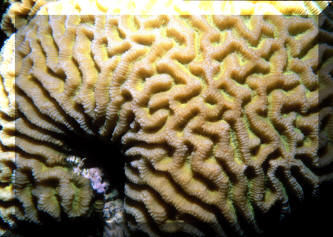 |
Bigger PIX:
The images in this table are linked to large (desktop size) copies. Click on
"framed" images to go to the larger size. |
|
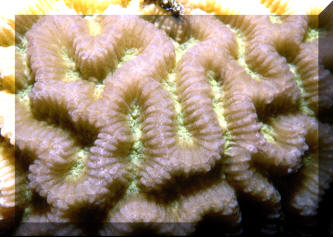
|
| Platygyra lamellina (Ehrenberg 1834). Massive
colonies whose corallites have thick walls that are uniform and rounded.
Fiji and Red Sea images. |
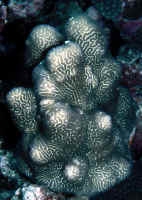
|
Bigger PIX:
The images in this table are linked to large (desktop size) copies. Click on
"framed" images to go to the larger size. |
|
%20MD.JPG)
|
| Platygyra sinensis (Milne Edwards and Haime
1849). Thin-walled septa that are outwardly facing. No obvious centers
(columellae). Fiji image. |
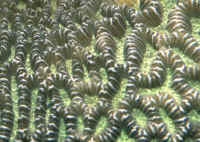 |
Bigger PIX:
The images in this table are linked to large (desktop size) copies. Click on
"framed" images to go to the larger size. |
|
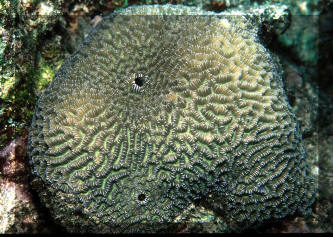
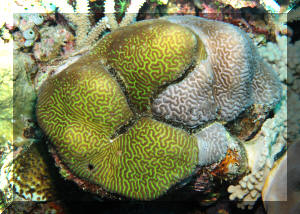
|

